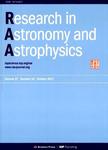Multi-color light curves and orbital period research of eclipsing binary V1073 Cyg
Multi-color light curves and orbital period research of eclipsing binary V1073 Cyg作者机构:Yunnan Observatories Chinese Academy of Sciences Kunming 650216 China Key Laboratory of the Structure and Evolution of Celestial Objects Chinese Academy of Sciences Kunming 650216 China University of Chinese Academy of Sciences Beijing 100049 China School of Physics and Electronic Engineering Sichuan University of Science & Engineering Zigong 643000 China
出 版 物:《Research in Astronomy and Astrophysics》 (天文和天体物理学研究(英文版))
年 卷 期:2018年第18卷第2期
页 面:83-92页
核心收录:
学科分类:07[理学] 070401[理学-天体物理] 0704[理学-天文学]
基 金:partly supported by the National Natural Science Foundation of China(Nos.11573063,11325315 and U1631108) the Key Science Foundation of Yunnan Province(No.2017FA001) Chinese Academy of Sciences“Light of West China”Program the research fund of Sichuan University of Science and Engineering(Grant No.2015RC42)
主 题:stars: binaries: close stars: binaries: eclipse stars: binaries: individual (V1073 Cyg)
摘 要:New multi-color BVRcIc photometric observations are presented for the W UMa type eclips- ing binary V1073 Cyg. The multi-color light curve analysis with the Wilson-Devinney procedure yielded the absolute parameters of this system, showing that V 1073 Cyg is a shallow contact binary system with a fill-out factor f = 0.124(±0.011). We collected all available times of light minima spanning 119yr, including CCD data to construct the O - C curve, and performed detailed O - C analysis. The O - C diagram shows that the period change is complex. A long-term continuous decrease and a cyclic vari- ation exist. The period is decreasing at a rate ofP = -1.04(±0.18) × 10-10 d cycle-land, with the period decrease, V1073 Cyg will evolve to the deep contact stage. The cyclic variation with a period of P3 = 82.7(±3.6) yr and an amplitude of A = 0.028(±0.002) d may be explained by magnetic activ- ity of one or both components or the light travel time effect caused by a distant third companion with M3(i1 = 90°) = 0.511 M⊙.



